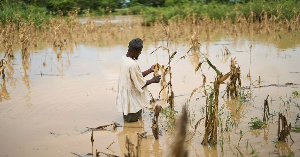General News of Saturday, 3 February 2018
Source: ghananewsagency.org
NGO calls on ASDA to increase education on sanitation and hygiene
A baseline study on sanitation and hygiene has called for a paradigm shift in the construction of communal/public toilets to household ones.
The study, which was conducted by Intervention Forum (IF), a non-governmental organisation, in the Awutu Senya District in the Central Region highlighted the need to step up education on sanitation and hygiene as one of the key areas for the Awutu Senya District Assembly (ASDA) to focus on in ameliorating the existing low access to improved household sanitary facilities.
The call stemmed from the study’s findings which identified most citizens (over 70 per cent) as still harbouring the notion that it was the Assembly’s responsibility to construct toilet facilities for them.
These and other recommendations followed the findings of the baseline study which was undertaken to make available a reliable database on current levels of sanitation services within the Awutu Senya District.
It was also to facilitate interventions by decision-makers to identify issues around poor sanitation and draw key decision-makers, media and other key actors into dialogue on how best to solve the identified issues.
Mr Isaac Owusu, a senior official of IF, presented the findings to the stakeholders at a district level interface meeting organised by IF under the Voice for Change (V4C) programme.
The V4C is an evidence-based advocacy programme being implemented by SNV (Netherlands Development Organisation) in partnership with the International Food and Policy Research Institute (IFPRI) and funded by the Dutch Ministry of Foreign Affairs (DGIS)), at Awutu Beraku.
The meeting was attended by officials from the Awutu Senya District Assembly (ASDA), including the Environmental Health Unit, Ghana Education Service, Ghana Health Service, Information Services Department, Community Development, Queenmothers, Area Council and Unit Committee members.
Mr Owusu also recommended the active collaboration of all WASH and non-WASH actors at the district and local levels towards achieving set targets.
He also advocated a concerted push by the Assembly towards Community-Led Total Sanitation (CLTS) implementation, adding that it needed to consider ceding revenue to modelling CLTS in selected communities within the district.
Specific areas covered by the survey included; time spent in fetching water, statistics on public toilet usage, practice of open defecation (OD), mode of waste water and solid waste disposal, and citizens’ access to sanitation and hygiene messages.
Other areas covered citizens’ assessment of performance of waste management companies, hand hygiene practices, and household hygiene and sanitation management practices, among others.
According to the survey, 54.3 percent of female public toilet facility users admitted to challenges such as lack of privacy (45.7 per cent) and high risk of contracting diseases (17.1 per cent).
The study also outlined that 11.4 percent of respondents cited as a challenge the constant fear of using the toilet facility at night due to darkness in such places.
With regard to the practice of Open Defecation (OD), approximately 24.2 percent admitted to practising OD as against the country’s overall rate of 19 percent, indicating that the Assembly needed to step up its efforts towards curbing OD as it was a critical SDG target.
On waste disposal, the study indicated that 8.1 of surveyed households disposed off the waste of their children under-5 years into gutters, bushes or streets, with 40.6 percent disposing them on public dumpsites or into public waste containers.
Most practitioners of OD said they resorted to it because they had no functional in-house toilets (42.9 per cent) or their existing toilets were not hygienic (30.6 per cent).
While 93.2 percent of these households saw OD as being wrong, they still practised it because they had no other option.
The study again cited peculiar challenges faced by female OD practitioners, with 47.4 percent citing challenges such as defecation areas being too exposed, fear of being sexually assaulted in bushes or defecation areas (23.7 per cent) and fear of using defecation areas at night (13.2 per cent).
The study also indicated that 76 percent of surveyed households said their toilet disposal situation needed improvement.
With regard to citizens’ knowledge of correlation between OD/indiscriminate waste disposal and flooding, 76.3 percent of respondents indicated that they saw no correlation between open defecation and/or indiscriminate waste disposal and instances of flooding within their communities.
“From these assessments, it can be safely affirmed that climate change education ought to be integrated into the information, education and communication (IEC) focus of the Assembly’s hygiene education efforts,’’ the study stated.
This can then use the results/outcomes as basis to lobby other targeted NGOs, banks and micro-financial institutions and private entities to come in with support.
Mr Owusu suggested that pragmatic steps be taken by the Assembly to engage microfinance institutions (MFIs), local banks and other private sector players on the prospects of branching into sanitation and hygiene service delivery as part of their Corporate Social Responsibility (CSR) initiatives.
‘’The adequate resourcing of the Environmental Health and Sanitation Unit of the Assembly should be accorded priority, given how consequential its day-to-day activities are in ensuring that improved outcomes in the WASH sector are secured,’’ he stated.
Again, the Assembly was asked to continue in its current direction of gazetting its bye-laws to ensure their greater sanitation enforcement, and that extensive education was carried out on it following its completion to improve awareness.
The sanitation and hygiene bye-laws also need to be enforced without fear or favour to ensure that punitive measures taken served as a deterrent to others and consideration should be given to the resourcing and periodic capacity strengthening of Area councils and the active involvement of Unit Committee members in sanitation and hygiene development processes.
This, he pointed out, would ensure their ability to better perform their roles to aid improved sanitation and hygiene management and premium should be placed on periodic evidence generation, regular monitoring and evaluation of S & H and updating existing data to inform planning for sanitation and hygiene service delivery.












